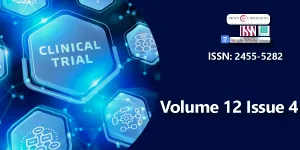Knowledge of Nurses about Communication Milestones at the Princess Marie Louise Children’s Hospital; A Qualitative Study
Main Article Content
Abstract
Abstract
Background: Communication milestones are critical indicators of children's developmental health and predictors of future academic and social outcomes. As frontline healthcare providers, nurses play a vital role in monitoring these milestones routinely. However, research suggests this surveillance role is often inadequately fulfilled, particularly regarding the identification of communication disorders in children aged 0-5 years.
Aim: This study aimed to assess nurses’ knowledge of communication milestones in children aged 0–5 years, examine their current practices regarding milestone surveillance, and identify training needs to enhance their capacity in monitoring communication development.
Method: This descriptive qualitative study was conducted from May to June 2020 at Princess Marie Louise Children's Hospital in Accra, Ghana. Twenty-six nurses (16 for questionnaires, 10 for interviews) with experience ranging from less than one year to 20 years participated in the study. Data collection included semi-structured questionnaires and in-depth interviews. The questionnaire assessed nurses' knowledge of communication milestones and clinical practices, while audio-recorded interviews explored their experiences, perceptions, and training needs. Data were analyzed using descriptive statistics for quantitative components and inductive thematic analysis for qualitative data.
Results: While 68.75% of nurses reported being able to identify changes in children's language development, most lacked detailed knowledge regarding specific communication milestones. The majority correctly identified some key milestones (75% for babbling before 6 months; 62.5% for first words between 6-12 months), but demonstrated inconsistent knowledge regarding expressive speech development. Key findings from the qualitative analysis revealed limited formal education on communication milestones, with participants noting it was insufficiently covered in their training curriculum. There was a complete absence of continuing professional development in this area, with just one participant reporting self-directed learning. While nurses demonstrated theoretical understanding of identifying communication difficulties, its application in clinical practice was inconsistent. Missed opportunities in identifying communication disorders were frequently attributed to workload constraints, time limitations, and inadequate clinical exposure. Parental education on communication milestones was minimal to non-existent due to both knowledge limitations and workplace pressures. Notably, all participants expressed a strong interest in further training, recognizing its value for improving early detection capabilities and enhancing parent education.
Conclusion: This study demonstrates significant gaps between perceived and actual knowledge of communication milestones among nurses in Ghana, with implications for early identification of developmental delays. Findings suggest the need for curriculum enhancement, implementation of standardized screening protocols, and targeted professional development programs. A collaborative approach involving speech-language therapists could strengthen both educational practices and clinical surveillance, ultimately improving developmental outcomes for children in Ghana and similar resource-limited settings.
Downloads
Article Details
Copyright (c) 2025 Boison R, et al.

This work is licensed under a Creative Commons Attribution 4.0 International License.
McEwin A, Santow E. The importance of the human right to communication. Int J Speech Lang Pathol. 2018;20(1):1-2. Available from: https://doi.org/10.1080/17549507.2018.1415548
UN General Assembly. United Nations Universal Declaration of Human Rights. In: Cahn S, Markie P, editors. Applied Ethics: A Multicultural Approach. 6th ed. Boston: Cengage Learning; 2017;54-57.
Baldikov N. Components of effective communication - Brosix [Internet]. 2021 [cited 2025 Apr 21]. Available from: https://www.brosix.com/blog/components-of-effective-communication/
National Institute on Deafness and Other Communication Disorders. Speech and language developmental milestones [Internet]. 2022 [cited 2025 Apr 21]. Available from: https://www.nidcd.nih.gov/health/speech-and-language?utm_source
Gervain J. Typical language development. Handb Clin Neurol. 2020;173:171-183. Available from: https://doi.org/10.1016/b978-0-444-64150-2.00016-2
Onnivello S, Schworer EK, Daunhauer LA, Fidler DJ. Acquisition of cognitive and communication milestones in infants with Down syndrome. J Intellect Disabil Res. 2021;67(3):239-253. Available from: https://doi.org/10.1111/jir.12893
Rupert J, Hughes P, Schoenherr D. Speech and language delay in children [Internet]. Am Fam Physician. 2023;108(2):181-188 [cited 2025 Apr 21]. Available from: https://www.aafp.org/pubs/afp/issues/2023/0800/speech-language-delay-children.html
Lipkin PH, Macias MM, Norwood KW, Brei TJ, Davidson LF, Davis BE, et al. Promoting optimal development: Identifying infants and young children with developmental disorders through developmental surveillance and screening. Pediatrics [Internet]. 2019;145(1):e20193449. Available from: https://doi.org/10.1542/peds.2019-3449
van der Merwe MN, Mosca R, Swanepoel DW, Glascoe FP, van der Linde J. Early detection of developmental delays in vulnerable children by community care workers using an mHealth tool. Early Child Dev Care. 2019;189(5):855-866. Available from: https://doi.org/10.1080/03004430.2018.1480481
Bello AI, Quartey JN, Appiah LA. Screening for developmental delay among children attending a rural community welfare clinic in Ghana. BMC Pediatr. 2013;13(1):119. Available from: https://link.springer.com/article/10.1186/1471-2431-13-119
National Institute on Deafness and Other Communication Disorders. Speech and language developmental milestones [Internet]. Natl Institutes Heal. 2010 [cited 2025 Apr 21]. Available from: https://www.nidcd.nih.gov/health/speech-and-language
Osei Appiah E, Appiah S, Kontoh S, Mensah S, Awuah DB, Menlah A, et al. Pediatric nurse-patient communication practices at Pentecost Hospital, Madina: A qualitative study. Int J Nurs Sci. 2022;9(4):481–489. Available from: https://doi.org/10.1016/j.ijnss.2022.09.009
Ertem IO. Developmental difficulties in early childhood: Prevention, early identification, assessment and intervention in low- and middle-income countries. Geneva: World Health Organization; 2012;1–112. Available from: https://www.who.int/publications/i/item/9789241503549
Tenny S, Brannan JM, Brannan GD. Qualitative study. In: StatPearls [Internet]. Treasure Island (FL): StatPearls Publishing; 2022 [cited 2022 Apr 24]; 93–187. Available from: https://www.ncbi.nlm.nih.gov/books/NBK470395/
Pizolato RA, Fonseca LMM, Bastos RS, Fernandes AY, Lefévre F, Maximino LP. Monitoring children's language development: knowledge and practices of primary health care professionals. Rev CEFAC. 2016;18(5):1109–1120. Available from: https://doi.org/10.1590/1982-0216201618520615
Braun V, Clarke V. Using thematic analysis in psychology. Qual Res Psychol. 2006;3(2):77–101. Available from: https://www.tandfonline.com/doi/abs/10.1191/1478088706QP063OA
Elo S, Kyngäs H. The qualitative content analysis process. J Adv Nurs. 2008;62(1):107–115. Available from: https://doi.org/10.1111/j.1365-2648.2007.04569.x
Rice ML, Sell MA, Hadley PA. Social interactions of speech- and language-impaired children. J Speech Hear Res. 1991;34(6):1299–1307. Available from: https://doi.org/10.1044/jshr.3406.1299
Kemker BK, Sumrall VL, Marx CG, Goshorn EL. Nurse’s awareness of hearing impaired patients’ communication needs. Online J Health Ethics. 2013;9. Available from: https://aquila.usm.edu/cgi/viewcontent.cgi?article=1048&context=ojhe

